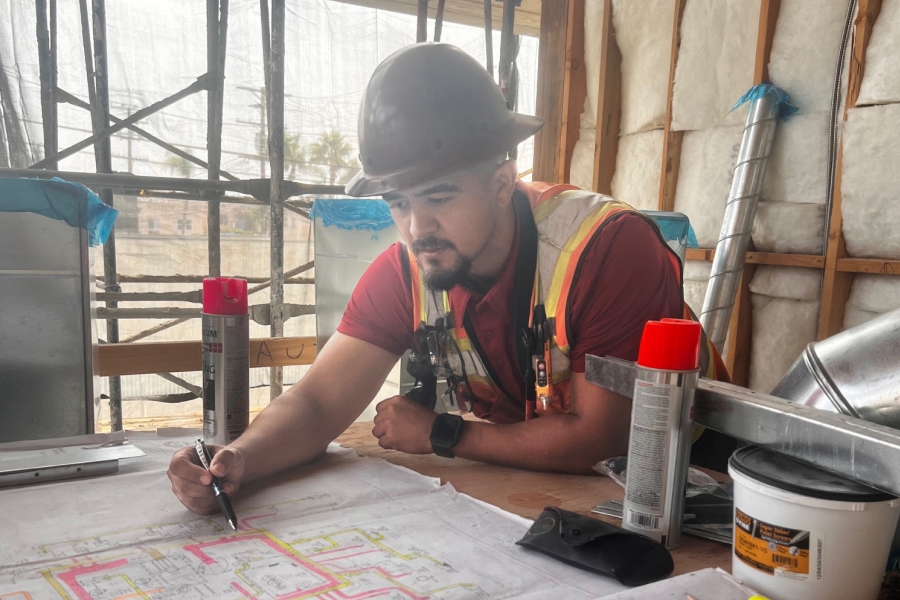Miami is home to world-class beaches, fabulous year-round weather, a vibrant culinary and entertainment culture and a blossoming technology startup scene to pair with the city’s long-established reputation as a hub for international business.
The city is also home to one of the biggest ongoing infrastructure projects in the United States: a nearly $1 billion transformation of the city’s sprawling highway system, culminating in a stunning Signature Bridge that will serve as another must-see centerpiece to Miami’s already-iconic downtown vista.
At the center of the project—a joint venture of The Walsh Group and The de Moya Group, and led by a partnership between the Florida Department of Transportation (FDOT) and the Miami-Dade Expressway Authority (MDX)—is Bluebeam Revu, which has become an essential document management technology for its workers.
“It’s incredible,” said Ronnie Alvarez, document control manager for The de Moya Group, of Revu. “I think it’s one of the greatest tools I’ve seen.”
Bustling tech hub?
Miami, already Florida’s biggest city before the COVID-19 pandemic, has seen its population surge in the past year. Florida overall added the second most new residents from July 2019 to July 2020, according to U.S. Census Bureau data; only Texas saw a bigger jump.
And with more workers leaving the Silicon Valley area in California amid the pandemic-fueled remote work boom, Miami’s tropical climate, diverse population and lack of state income tax has made it somewhat of a startup hot spot. The Miami-area technology scene raised close to $1 billion in venture funding in 2020, according to Crunchbase data. Miami’s mayor, Francis X. Suarez, is leaning into the trend by strongly vocalizing a desire for the city to become the next big technology hub.
The influx of new residents isn’t likely to alleviate Miami’s traffic problem, which has long been a staple for the city as sprawling highways and poor public transportation create massive motorist congestion. “As Miami’s rush hour traffic continues to increase, projects like the Signature Bridge can make a tremendous difference,” said Alvarez, who’s lived in the area since he was 16 years old.

One of the roughest patches in Miami is near the city’s Overtown neighborhood, close to the I-95/I-395 interchange, leading east to the MacArthur Causeway Bridge that guides drivers through Star, Plum and Hibiscus Islands on the way to Miami Beach.
The $818 million project, set to be completed in 2024, is designed to decongest this area’s troublesome traffic and improve overall motorist flow. It is split into three segments.
The first segment is a series of SR-836 enhancements, which span from NW 17 Avenue to the Midtown Interchange and include building a double-decked highway beginning just east of the toll gantry at NW 17, rising over the center of SR-836 and touching down at I-395, just east of the I-95 interchange.
The second segment features enhancements from NW 8 Street to NW 29 Street, including a total replacement of the concrete pavement for both the northbound and southbound travel lanes and an auxiliary lane added along northbound I-95 from north of NW 17 Street to NW 29 Street.
The final segment includes enhancements along I-395 toward the approximately 1.4-mile-long MacArthur Causeway. This segment will completely reconstruct the existing facility and create the 1,025-foot Signature Bridge over NE 2 Avenue and SR-5/Biscayne Boulevard.

The Signature Bridge will showcase six sweeping arches, which will light up at night. The bridge and adjoining structures will also allow for the transformation of an underneath area that will be built into a community space.
The project’s massive scope is a boon for the local construction job market.
“We’ve got a little more than 400 people on site” working on the project, said Josh McDermott, a project segment manager with The Walsh Group.
Revu to the rescue
Building such a complex project requires that organization and coordination of plan documents be seamless and error-free. Therefore, when Alvarez, tasked with implementing a system for all documentation, officially joined the project in 2019, Bluebeam Revu became his go-to technology. “The plan was to use Bluebeam from the beginning as the main tool for document management and collaboration,” Alvarez said.
“When I speak about documentation, I’m referring to everything from design plans, calculations, construction submittals, correspondence, etc.,” Alvarez said. “My main goal as the joint venture’s document control manager was to assess and improve the processes in place.”
As part of this job, Alvarez is constantly meeting with various project stakeholders, ensuring that everyone has the “latest and greatest” drawings in the field. He is also responsible for submitting documentation to the different engineers, FDOT and MDX for review and approval. “My days are very active, as you can imagine,” Alvarez said.

Studio in Revu has been especially essential for Alvarez. The document management capability in Revu, Studio Projects, is where all the Signature Bridge documents are organized. Alvarez said he has also integrated the project’s document storage with Microsoft SharePoint. “Bluebeam Studio allows me to upload and link all project-related documents to one portal, making it simple for all project team members to find the desired information,” Alvarez said.
Alvarez then has all the project’s documents in Studio Projects set up in a hierarchy of folders within the project files that are then linked to a dynamic project dashboard.
A project dashboard, which The Walsh Group pioneered use of on its other projects, is essentially a user-friendly navigation page that links to project documents and other helpful information so they can be easily accessed in the field. Anyone can pull up a project dashboard and, within a few clicks, locate specific documents for reference in the field, lightening the clutter and confusion that often comes with navigating through piles of paper-based documents.
The dashboard for the Signature Bridge project includes everything from plan specifications, RFIs, daily work plans, calendars, submittals, progress drawings and final plans.
W. David Scott, a Walsh Group project manager on the project, said the Bluebeam dashboards have been a must-have tool for workers on the jobsite and in the office. “It makes it really easy to go there and locate anything that we need,” Scott said.

Alvarez also takes advantage of Studio Sessions in Revu, which allows for real-time document review and collaboration. Anytime Alvarez needs approval on a document, he simply creates a Studio Session, invites his counterpart to join the Session, uploads the document(s) and identifies within the Session what needs the other person’s review and sign-off.
“This project is fully electronic, which means that information can be accessed almost instantly,” Alvarez said. “So, for example, if I get a set of drawings that have been released for construction, I go into my Studio Project and locate or create a new set according to the discipline. Once that’s done, the next step would be to send a notification to the team advising them that new released for construction drawings have been posted.”
Marking up complexity
Besides using Revu for document control and organization, others on the Signature Bridge project have found tools in the technology that have quickly become essential.
Quantity Link, which allows users to measure specific areas on a document and then track those quantities in a Microsoft Excel spreadsheet, has been vital. “I think probably one of my favorite features of Bluebeam personally is just the way that it keeps track from a takeoff standpoint,” said McDermott, the project segment manager. “And you can export back and forth to Excel.”

Indeed, McDermott’s use of Revu on the project has extended beyond its construction-specific purposes.
“It’s a great way for me to be able to manage our cost reports and our revenue,” McDermott added. “I’m able to make notes and collaborate again with individuals to make sure they’re being managed and doing what basically I’m telling them—so I think it’s a good management tool, too.”
The Markups capability in Revu has also helped workers streamline efficiency and communication in the field. “Whenever we’re marking up a document, it’s easy to go back on a 900-page document down to the comments and drag the bar and be able to locate the comments really quickly—instead of going page by page looking for comments,” said Scott, the project manager.
The Signature Bridge project team hasn’t yet made efforts to specifically measure the potential cost and time savings to come from using Revu. But Alvarez said the technology’s value is relentlessly apparent. “It makes the process a lot easier and smoother, and team members can receive information in a much faster and efficient way,” Alvarez said.
Scott, too, said Revu’s value is obvious. “It’s a time-saver for sure,” he said. “Revu makes it easy and updates plans quickly where I don’t have to go track down new revisions, especially on documents. It streamlines the process.”
As the Signature Bridge project continues into its most critical phases, Revu’s cost- and time-savings capability, as well as its value in mitigating document control errors, should make a lasting impact on the project’s success, allowing Miami’s residents to enjoy both the bridge’s traffic relief and visual aesthetic sooner rather than later.











